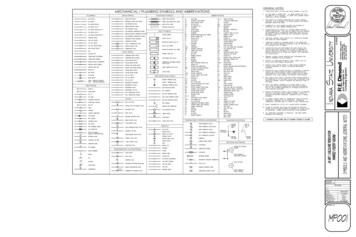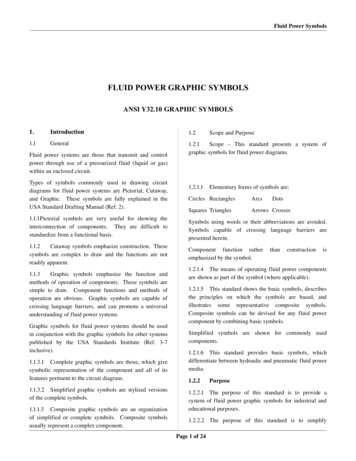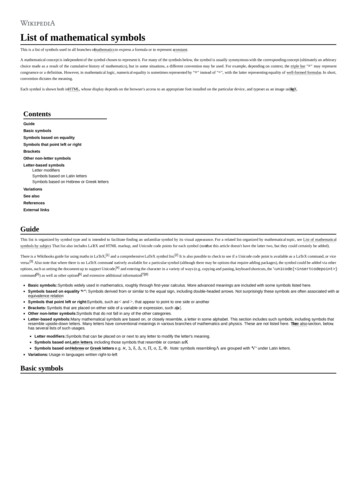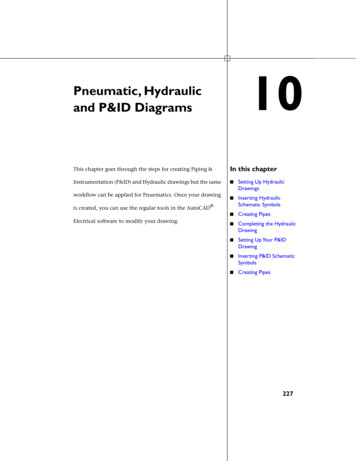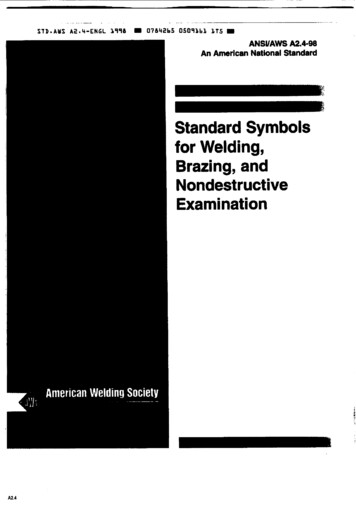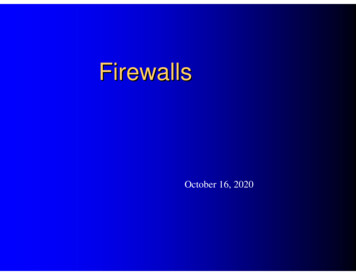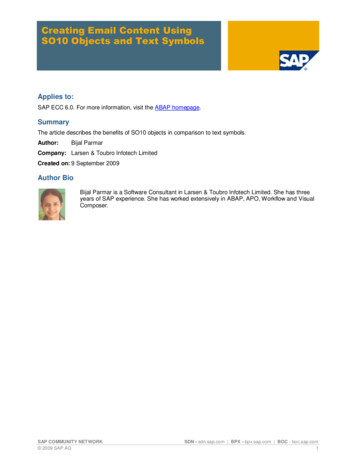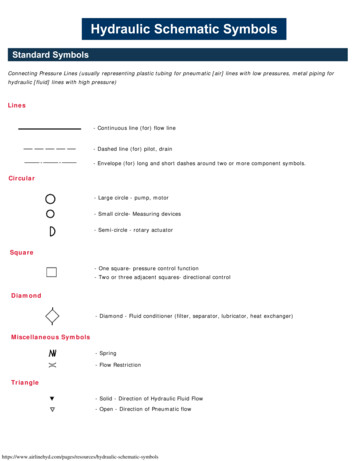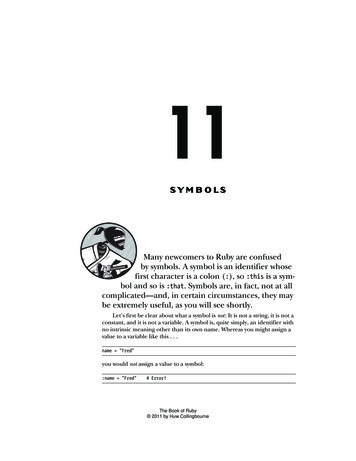
Transcription
SYMBOLSMany newcomers to Ruby are confusedby symbols. A symbol is an identifier whosefirst character is a colon (:), so :this is a symbol and so is :that. Symbols are, in fact, not at allcomplicated—and, in certain circumstances, they maybe extremely useful, as you will see shortly.Let’s first be clear about what a symbol is not: It is not a string, it is not aconstant, and it is not a variable. A symbol is, quite simply, an identifier withno intrinsic meaning other than its own name. Whereas you might assign avalue to a variable like this . . .name "Fred"you would not assign a value to a symbol::name "Fred"# Error!The Book of Ruby 2011 by Huw Collingbourne
The value of a symbol is itself. So, the value of a symbol called :nameis :name.NOTEFor a more technical account of what a symbol is, refer to“Digging Deeper” on page 190.You have, of course, used symbols before. In Chapter 2, for instance, youcreated attribute readers and writers by passing symbols to the attr readerand attr writer methods, like this:attr reader( :description )attr writer( :description )You may recall that the previous code causes Ruby to create a @descriptioninstance variable plus a pair of getter (reader) and setter (writer) methodscalled description. Ruby takes the value of a symbol literally. The attr readerand attr writer methods create, from that name, variables and methods withmatching names.Symbols and StringsIt is a common misconception that a symbol is a type of string. After all, isn’tthe symbol :hello pretty similar to the string "hello"? In fact, symbols are quiteunlike strings. For one thing, each string is different—so, as far as Ruby isconcerned, "hello", "hello", and "hello" are three separate objects with threeseparate object ids.symbol ids.rb# These 3 strings have 3 different object idsputs( "hello".object id ) # 16589436puts( "hello".object id ) # 16589388puts( "hello".object id ) # 16589340But a symbol is unique, so :hello, :hello, and :hello all refer to the sameobject with the same object id.# These 3 symbols haveputs( :hello.object idputs( :hello.object idputs( :hello.object idthe same object id) # 208712) # 208712) # 208712In this respect, a symbol has more in common with an integer than witha string. Each occurrence of a given integer value, you may recall, refers tothe same object, so 10, 10, and 10 may be considered to be the same object,and they have the same object id. Remember that the actual IDs assigned toobjects will change each time you run a program. The number itself is not182Chapter 11The Book of Ruby 2011 by Huw Collingbourne
significant. The important thing to note is that each separate object alwayshas a unique ID, so when an ID is repeated, it indicates repeated referencesto the same object.ints and symbols.rb# These three symbols have the same object idputs( :ten.object id ) # 20712puts( :ten.object id ) # 20712puts( :ten.object id ) # 20712# These three integers have the same object idputs( 10.object id )# 21puts( 10.object id )# 21puts( 10.object id )# 21You can also test for equality using the equal? method:symbols strings.rbputs( :helloworld.equal?( :helloworld ) )puts( "helloworld".equal?( "helloworld" ) )puts( 1.equal?( 1 ) )# true# false# trueBeing unique, a symbol provides an unambiguous identifier. You canpass symbols as arguments to methods, like this:amethod( :deletefiles )A method might contain code to test the value of the incoming argument:symbols 1.rbdef amethod( doThis )if (doThis :deletefiles) thenputs( 'Now deleting files.')elsif (doThis :formatdisk) thenputs( 'Now formatting disk.')elseputs( "Sorry, command not understood." )endendSymbols can also be used in case statements where they provide both thereadability of strings and the uniqueness of integers:case doThiswhen :deletefiles then puts( 'Now deleting files.')when :formatdisk then puts( 'Now formatting disk.')else puts( "Sorry, command not understood." )endS ym bo lsThe Book of Ruby 2011 by Huw Collingbourne183
The scope in which a symbol is declared does not affect its uniqueness.Consider the following:symbol ref.rbmodule Oneclass Fredend f1 :Fredendmodule TwoFred 1 f2 :Fredenddef Fred()end f3 :FredHere, the variables f1, f2, and f3 are assigned the symbol :Fred in threedifferent scopes: module One, module Two, and the “main” scope. Variablesstarting with are global, so once created, they can be referenced anywhere.I’ll have more to say on modules in Chapter 12. For now, just think of themas “namespaces” that define different scopes. And yet each variable refers tothe same symbol, :Fred, and has the same object id.# Allputs(puts(puts(three display f1.object id f2.object id f3.object idthe same id!) # 208868) # 208868) # 208868Even so, the “meaning” of the symbol changes according to its scope.In module One, :Fred refers to the class Fred; in module Two, it refers to theconstant Fred 1; and in the main scope, it refers to the method Fred.A rewritten version of the previous program demonstrates this:symbol ref2.rbmodule Oneclass Fredend f1 :Freddef self.evalFred( aSymbol )puts( eval( aSymbol.id2name ) )endendmodule TwoFred 1 f2 :Freddef self.evalFred( aSymbol )puts( eval( aSymbol.id2name ) )endend184Chapter 11The Book of Ruby 2011 by Huw Collingbourne
def Fred()puts( "hello from the Fred method" )end f3 :FredFirst I access the evalFred method inside the module named One using twocolons (::), which is the Ruby “scope resolution operator.” I then pass f1 tothat method:One::evalFred( f1 )In this context, Fred is the name of a class defined inside module One, sowhen the :Fred symbol is evaluated, the module and class names are displayed:One::FredNext I pass f2 to the evalFred method of module Two:Two::evalFred( f2 )In this context, Fred is the name of a constant that is assigned the integer1, so that is what is displayed: 1. And finally, I call a special method calledsimply method. This is a method of Object. It tries to find a method with thesame name as the symbol passed to it as an argument and, if found, returnsthat method as an object that can then be called:method( f3).callThe Fred method exists in the main scope, and when called, its output isthis string:"hello from the Fred method"Naturally, since the variables f1, f2, and f3 reference the same symbol,it doesn’t matter which variable you use at any given point. Any variable towhich a symbol is assigned, or, indeed, the symbol itself, will produce thesame results. The following are equivalent:One::evalFred( f1 )Two::evalFred( f2 )method( f3).call# One::Fred# 1# hello from the Fred methodOne::evalFred( f3 )Two::evalFred( f1 )method( f2).call# One::Fred# 1# hello from the Fred methodS ym bo lsThe Book of Ruby 2011 by Huw Collingbourne185
One::evalFred( :Fred )Two::evalFred( :Fred )method(:Fred).call# One::Fred# 1# hello from the Fred methodSymbols and VariablesTo understand the relationship between a symbol and an identifier such as avariable name, take a look at the symbols 2.rb program. It begins by assigningthe value 1 to a local variable, x. It then assigns the symbol :x to a local variable, xsymbol:symbols 2.rbx 1xsymbol :xAt this point, there is no obvious connection between the variable xand the symbol :x. I have declared a method that simply takes some incoming argument and inspects and displays it using the p method. I can call thismethod with the variable and the symbol:def amethod( somearg )p( somearg )end# Test 1amethod( x )amethod( :x )This is the data that the method prints as a result:1:xIn other words, the value of the x variable is 1, since that’s the valueassigned to it and the value of :x is :x. But the interesting question that arisesis this: If the value of :x is :x and this is also the symbolic name of the variablex, would it be possible to use the symbol :x to find the value of the variable x?Confused? I hope the next line of code will make this clearer:# Test 2amethod( eval(:x.id2name))Here, id2name is a method of the Symbol class. It returns the name or stringcorresponding to the symbol (the to s method would perform the same function); the end result is that, when given the symbol :x as an argument, id2namereturns the string “x.” Ruby’s eval method (which is defined in the Kernel186Chapter 11The Book of Ruby 2011 by Huw Collingbourne
class) is able to evaluate expressions within strings. In the present case, thatmeans it finds the string “x” and tries to evaluate it as though it were executable code. It finds that x is the name of a variable and that the value of x is 1.So, the value 1 is passed to amethod. You can verify this by running symbols2.rb.NOTEEvaluating data as code is explained in more detail in Chapter 20.Things can get even trickier. Remember that the variable xsymbol hasbeen assigned the symbol :x.x 1xsymbol :xThat means that if you eval :xsymbol, you can obtain the name assigned toit—that is, the symbol :x. Having obtained :x, you can go on to evaluate thisalso, giving the value of x, namely, 1:# Test 3amethod(amethod(amethod(amethod(xsymbol ):xsymbol )eval(:xsymbol.id2name))eval( ( eval(:xsymbol.id2name)).id2name ) )# # # # :x:xsymbol:x1As you’ve seen, when used to create attribute accessors, symbols can referto method names. You can make use of this by passing a method name as asymbol to the method method and then calling the specified method using thecall method:#Test 4method(:amethod).call("")The call method lets you pass arguments, so, just for the heck of it, youcould pass an argument by evaluating a symbol:method(:amethod).call(eval(:x.id2name))If this seems complicated, take a look at a simpler example in symbols 3.rb.This begins with this assignment:symbols 3.rbdef mymethod( somearg )print( "I say: " somearg )endthis is a method name method(:mymethod)S ym bo lsThe Book of Ruby 2011 by Huw Collingbourne187
Here method(:mymethod) looks for a method with the name specified by thesymbol passed as an argument (:mymethod), and if one is found, it returns theMethod object with the corresponding name. In my code I have a methodcalled mymethod, and this is now assigned to the variable this is a method name.When you run this program, you will see that the first line of outputprints the value of the variable:puts( this is a method name )# # Method: Object#mymethod This shows that the variable this is a method name has been assigned themethod, mymethod, which is bound to the Object class (as are all methods that areentered as “freestanding” functions). To double-check that the variable reallyis an instance of the Method class, the next line of code prints out its class:puts( "#{this is a method name.class}" )# MethodOkay, so if it’s really and truly a method, then you should be able to callit, shouldn’t you? To do that, you need to use the call method. That is whatthe last line of code does:this is a method name.call( "hello world" )# I say: hello worldWhy Use Symbols?Some methods in the Ruby class library specify symbols as arguments. Naturally, if you need to call those methods, you are obliged to pass symbols tothem. Other than in those cases, however, there is no absolute requirementto use symbols in your own programming. For many Ruby programmers, the“conventional” data types such as strings and integers are perfectly sufficient.However, many Ruby programmers do like to use symbols as the keys intohashes. When you look at the Rails framework in Chapter 19, for example,you will see examples similar to the following:{ :text "Hello world" }Symbols do have a special place in “dynamic” programming, however.For example, a Ruby program is able to create a new method at runtime bycalling, within the scope of a certain class, define method with a symbol representing the method to be defined and a block representing the code of themethod:add method.rb188class Arraydefine method( :aNewMethod, lambda{ *args puts( args.inspect)} )endChapter 11The Book of Ruby 2011 by Huw Collingbourne
After the previous code executes, the Array class will have gained amethod named aNewMethod. You can verify this by calling method defined? witha symbol representing the method name:Array.method defined?( :aNewMethod )# trueAnd, of course, you can call the method itself:[].aNewMethod( 1,2,3# [1,2,3]You can remove an existing method at runtime in a similar way by callingremove method inside a class with a symbol providing the name of the methodto be removed:class Arrayremove method( :aNewMethod )endDynamic programming is invaluable in applications that need to modify thebehavior of the Ruby program while that program is still executing. Dynamicprogramming is widely used in the Rails framework, for example, and it isdiscussed in depth in the final chapter of this book.S ym bo lsThe Book of Ruby 2011 by Huw Collingbourne189
DIGGING DEEPERSymbols are fundamental to Ruby. Here you will learn why that is so and howyou can display all the symbols available.What Is a Symbol?Previously, I said that a symbol is an identifier whose value is itself. Thatdescribes, in a broad sense, the way that symbols behave from the point ofview of the Ruby programmer. But it doesn’t tell you what symbols are literallyfrom the point of view of the Ruby interpreter. A symbol is, in fact, a pointerinto the symbol table. The symbol table is Ruby’s internal list of known identifiers—such as variable and method names.If you want to take a peek deep inside Ruby, you can display all the symbols that Ruby knows about like this:allsymbols.rbp( Symbol.all symbols )This will shows thousands of symbols including method names such as:to s and :reverse, global variables such as : / and : DEBUG, and class namessuch as :Array and :Symbol. You may restrict the number of symbols displayedusing array indexes like this:p( Symbol.all symbols[0,10] )In Ruby 1.8, you can’t sort symbols since symbols are not considered tobe inherently sequential. In Ruby 1.9, sorting is possible, and the symbolcharacters are sorted as though they were strings:# In Ruby 1.9p [:a,:c,:b].sort# [:a,:b,:c]# In Ruby 1.8p [:a,:c,:b].sort# 'sort': undefined method ' ' for :a:SymbolThe easiest way to display a sorted list of symbols in a way that avoidsincompatibility problems related to Ruby versions is to convert the symbols tostrings and sort those. In the following code, I pass all the symbols known toRuby into a block, convert each symbol to a string, and collect the strings intoa new array that is assigned to the str array variable. Now I can sort this arrayand display the results:str arr Symbol.all symbols.collect{ s s.to s }puts( str arr.sort )190Chapter 11The Book of Ruby 2011 by Huw Collingbourne
You may recall that the previous code causes Ruby to create a @description instance variable plus a pair of getter (reader) and setter (writer) methods called description. Ruby takes the value of a symbol literally. The attr_reader and attr_writer methods create, from that na me, varia
